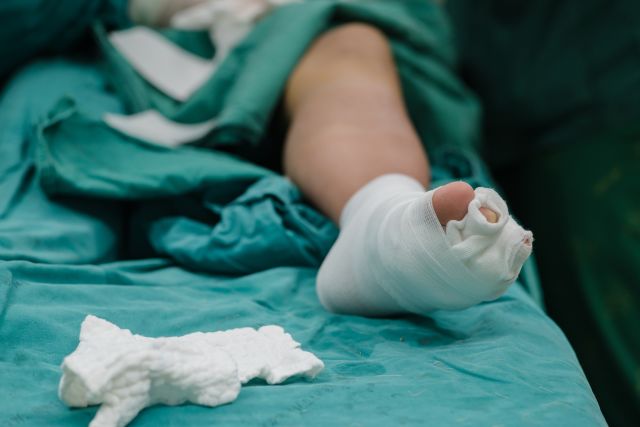Do you have a wound that seems to be taking forever to heal? If it's been a month or even longer, it could be a sign of a more serious issue.
By definition, a wound is any type of injury that either breaks the skin or damages tissues, physically disrupting the structure of some part of the body. Wounds can be cuts, scrapes, scratches, burns, or punctures, and they sometimes affect tissue beneath the skin.
Most wounds are considered “acute,” meaning they eventually heal while following a somewhat predictable timeline. Keep in mind, you may heal at a different rate than someone else. The duration of the healing process depends on a variety of factors, including your health and age as well as the size and attributes of the wound itself.
In some cases, other issues—such as an infection or insufficient supply of blood, oxygen and nutrients—prevent a wound from healing normally. “Chronic wounds are those in which the healing process stalls in some way and doesn’t progress as it should,” explains Rohini Sharma, MD, an infectious disease specialist at North Suburban Wound Care & Hyperbarics in Thornton, Colorado.
What are the risk factors for chronic wounds?
Wounds that are particularly severe (large, deep, or complex) or that become infected may take an unusually long time to heal—or may not heal at all without medical intervention. They may take months to heal, and often require regular visits to a wound care clinic to be cleaned, dressed, and treated.
“But it’s not only the healing timeline that differentiates an acute wound from a chronic one,” Dr. Sharma explains. If you have certain underlying health conditions, your risk for having a wound become chronic increases. “One’s age, as well as having diabetes, a weakened immune function, or poor circulation can all contribute,” she says.
In other words, what might be a relatively trivial injury (say, a cut or scrape) in an otherwise healthy person could turn into a chronic wound in someone with poorly managed diabetes who also has nerve damage or poor circulation. “In susceptible populations, any wound, even a minor wound, is something that needs to be monitored very carefully,” Sharma notes.
Because blood supply plays a key role in the natural healing process, many of the underlying conditions that can cause or increase the risk for chronic wounds involve impaired blood vessel function and blood flow. Other risk factors involve immune function, lifestyle habits, and the use of certain medications. The major factors include:
Venous insufficiency: This occurs when the veins in the legs have trouble keeping blood flowing back to the heart as usual. Having deep vein thrombosis (a blood clot that forms in a vein deep in the body), being overweight, having previous injury to the legs, a family history of varicose veins, and unhealthy habits (such as smoking, lack of exercise, and sitting or standing for long periods of time) can all increase the risk for venous insufficiency. For those with this condition, even small injuries to the legs can turn into chronic wounds.
Diabetes: People with uncontrolled diabetes don’t metabolize sugars that enter the bloodstream in the usual way, which can damage the blood vessels and impair their function. Wounds that would otherwise be acute can become chronic due to circulation problems that limit the flow of blood to these injured areas. Elevated blood sugar levels also increase the likelihood that a wound may become infected.
When diabetes patients also have peripheral neuropathy—a form of nerve damage that causes decreased sensation in the extremities—they may be more susceptible to and less aware of injuries to the skin on their feet. As a result, their wounds may go untreated and become infected all the way down to the underlying bone. In severe cases, this could require amputation, so preventing these wounds—and identifying them quickly if they do develop—is imperative.
Obesity: People who are obese are more likely to have poor blood flow to the skin, which can lead to wound infection.
Poor circulation: Heart disease can cause narrowed blood vessels and, in turn, poor circulation. If wounds don’t get enough oxygen or other nutrients due to impaired blood flow, they may take longer to heal. If a doctor suspects a patient may have peripheral arterial disease—a condition marked by narrowed arteries and reduced blood flow to the limbs—their wounds will need to be monitored closely.
Weakened immune function: Cancer patients, the elderly, or those with a poor diet, among others, may have compromised immune systems, which can lead to slower than normal wound healing.
Being confined to a bed or wheelchair: Spending extended amounts of time sitting, lying in bed, or using a wheelchair can put pressure on the parts of the body in constant contact with an external surface. Such pressure can lead to pressure ulcers, also known as bedsores, which can develop into chronic wounds.
Use of certain drugs, medications, and therapies: Steroids (often prescribed for asthma, rheumatoid arthritis, and some cancers) can interfere with the body’s ability to repair its own cells.
Other therapies, like radiation or chemotherapy, can also increase chronic wound risk. Although chemotherapies are designed to stop cancer cells from growing and multiplying, they can also stop “good” cells in your body (like those involved in wound healing) from flourishing, too. Patients on chemotherapy need to be followed carefully to make sure their wounds heal properly.
Smoking and drinking alcohol: The chemicals in tobacco smoke can reduce blood flow, impede oxygen from reaching the skin and other tissues in the body, and inhibit the immune response—all factors that contribute to impaired wound healing. Drinking excessive amounts of alcohol can also lead to insulin resistance and high blood sugar levels as well as malnutrition, which together can dampen the immune system and slow the growth of new tissue.
Protein malnutrition: A diet that’s deficient in protein can interfere with the immune system’s response to injuries as well as the body’s ability to grow connective tissue cells and repair blood vessels. All of these functions are key for proper wound healing. Inadequate protein intake is common among the elderly and one of the factors that puts members of this age group at higher risk for chronic wounds.
Severe injuries or tissue damage: The more extensive the injury and the more severe the damage, the longer healing will take and the more likely complications will arise—meaning the wound will probably need to be managed as a chronic one. Any longstanding wound is at risk for infection, which could lead to a deeper bone infection that could ultimately necessitate amputation in extreme circumstances. Limb salvage programs—found at some medical centers and often involving podiatrists, orthopedic surgeons, infectious disease doctors, and vascular specialists including cardiologists, interventional radiologists, and surgeons—seek to avoid these outcomes.
Previous chronic wounds: If you currently have or had a chronic wound, subsequent wounds are less likely to heal normally. People with prior chronic wounds are at higher risk for additional ones because of the underlying risk factors that led to their first one, Sharma explains.
Vigilance is necessary
If a wound seems to be taking longer than usual to heal—for example, a cut you would expect to heal in a week or two is lingering for a month or longer—it’s important to visit your doctor to see what’s going on, Sharma says. Your doctor may refer you to a wound care clinic.
The bottom line: “Anyone diagnosed with or being treated for a chronic wound needs to know that it is multifactorial,” Sharma says. This means that effective treatment of chronic wounds requires a broad understanding of a patient’s overall health by the wound care provider and a dedicated commitment on the part of both the healthcare team and the patient to take advantage of a full spectrum of care.






